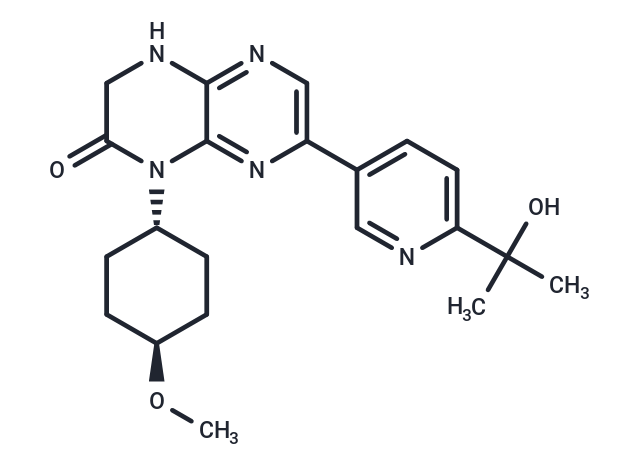Shopping Cart
- Remove All
 Your shopping cart is currently empty
Your shopping cart is currently empty

Onatasertib (CC223) is an orally available mTOR inhibitor with potential antitumor activity. Onatasertib inhibits the activity of mTOR, which may result in the induction of tumor cell apoptosis and a decrease in tumor cell proliferation. Onatasertib is a potent mTOR kinase inhibitor (IC50: 16 nM), with >150-fold sensitivity than the related lipid kinase PI3Kα (IC50: 4 μM).

| Pack Size | Price | Availability | Quantity |
|---|---|---|---|
| 1 mg | $35 | In Stock | |
| 5 mg | $81 | In Stock | |
| 10 mg | $129 | In Stock | |
| 25 mg | $248 | In Stock | |
| 50 mg | $413 | In Stock | |
| 100 mg | $591 | In Stock | |
| 1 mL x 10 mM (in DMSO) | $89 | In Stock |
| Description | Onatasertib (CC223) is an orally available mTOR inhibitor with potential antitumor activity. Onatasertib inhibits the activity of mTOR, which may result in the induction of tumor cell apoptosis and a decrease in tumor cell proliferation. Onatasertib is a potent mTOR kinase inhibitor (IC50: 16 nM), with >150-fold sensitivity than the related lipid kinase PI3Kα (IC50: 4 μM). |
| Targets&IC50 | mTOR:16 nM |
| In vitro | In mice with PC-3 tumor xenografts, CC-223 (25 mg/kg, p.o.) inhibited the activity of both mTORC1 and mTORC2. Additionally, CC-223 (25 mg/kg, p.o.) suppressed tumor growth across several models, including those for prostate cancer, glioblastoma, breast cancer, lung cancer, and colorectal cancer, achieving inhibition rates between 47%-95%. |
| In vivo | In numerous cell lines, CC-223 effectively inhibits markers of both mTORC1 (S6RP and 4EBP1) and mTORC2 [AKT(S473)], with IC50 values for pAKT(S473) ranging from 11-150 nM, pS6RP from 27-184 nM, and p4EBP1 from 120-1050 nM. Additionally, CC-223 suppresses the growth of various cancer cell lines and induces apoptosis. |
| Kinase Assay | Kinase assays mTOR.: Reagents are prepared as follows:"Simple Tor buffer": 10 mM Tris pH 7.4, 100 mM NaCl, 0.1% Tween-20, 1 mM DTT. Recombinant mTOR is diluted in this buffer to an assay concentration of 0.200ug/mL. ATP/Substrate solution: 0.075 mM ATP, 12.5 mM MnCl2, 50 mM Hepes, pH 7.4, 50 mM β-GOP, 250 nM Microcystin LR, 0.25 mM EDTA, 5 mM DTT, and 3.5 μg/mL GST-p70S6. Dilution Curve: A 10-point, 1:3 dilution of compounds are prepared in neat DMSO at 50 times the final assay concentration. Detection reagent mix: 50 mM HEPES, pH 7.4 0.01% Triton X-100, 0.01% BSA, 0.1 mM EDTA, 12.7 ug/mL Cy5-anti-GST antibody, 9 ng/ml anti-phospho p70S6 antibody (Thr389), 627ng/mL anti-mouse IgG labeled with Lance Eu. To 20 uL of the Simple Tor buffer is added 0.5 uL of the compound Dilution Curve in DMSO. The final concentration range for compound is 30 to 0.0015 μM. To initiate the reaction, 5 μL of the ATP/substrate solution is added to the above. The reaction is allowed to run for 60 minutes. The assay is stopped by adding 5 μL of 60 mM EDTA. Ten (10) μL of detection reagent mix is then added, and the mixture is allowed to sit at least 2 hours before reading on a Perkin Elmer Envision microplate reader set to detect Europium-based TR-FRET. |
| Cell Research | Compound is spotted via an acoustic dispenser (EDC ATS-100) into an empty 384-well plate. Cells are diluted to desired densities and added directly to the compound-spotted plates. Cells are allowed to grow for 72 hours. Viability is assessed via Cell Titer-Glo. All data are normalized and represented as a percentage of the DMSO-treated cells. Results are then expressed as GI50 and/or IC50 values.(Only for Reference) |
| Alias | CC-223, CC223, CC 223 |
| Molecular Weight | 397.47 |
| Formula | C21H27N5O3 |
| Cas No. | 1228013-30-6 |
| Smiles | CO[C@H]1CC[C@@H](CC1)N1C(=O)CNc2ncc(nc12)-c1ccc(nc1)C(C)(C)O |
| Relative Density. | 1.37 g/cm3 (Predicted) |
| Storage | Powder: -20°C for 3 years | In solvent: -80°C for 1 year | Shipping with blue ice. | |||||||||||||||||||||||||||||||||||
| Solubility Information | DMSO: 70 mg/mL (176.11 mM), Sonication is recommended. Ethanol: 73 mg/mL (183.7 mM) H2O: < 1 mg/mL (insoluble or slightly soluble) | |||||||||||||||||||||||||||||||||||
Solution Preparation Table | ||||||||||||||||||||||||||||||||||||
DMSO/Ethanol
| ||||||||||||||||||||||||||||||||||||

Copyright © 2015-2024 TargetMol Chemicals Inc. All Rights Reserved.